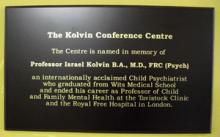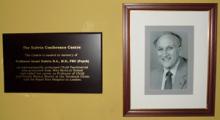Speech given at the opening ceremony of the Kolvin Conference Centre on 13th March 2012
Israel Kolvin, known to relatives and friends as Issy, died March 12th 2002 aged 72. His father died when Issy was young and the family was not wealthy, so in order to train as a doctor Issy had to work his way through medical school. He was assisted in this by his wife, Rona, who also took on a job to help him with the expense of training.

Plaque at the Kolvin Conference Centre
His choice of a specialty was influenced by the deprivation and malnutrition he saw in children at the Baragwanath hospital, Soweto, where he worked as a junior doctor, as well as by the severe psychiatric conditions he met in the emergency room. Issy came to Britain in 1958 to train in psychiatry, first in Edinburgh, and then in Oxford. With the encouragement of Kit Ounsted, a well-known child psychiatry researcher, he embarked on his first important study, demonstrating that childhood autism and schizophrenia were distinct entities - something not previously understood - and helped to clarify that autism is a developmental disorder. In 1964 Issy became physician in charge of the Nuffield psychology and psychiatry unit in Newcastle-upon-Tyne. In 1977, he was appointed to a personal chair in child psychiatry at Newcastle University, where he established a lively and productive academic and clinical centre, which attracted many talented researchers.
One of the major studies to come out of Issy’s time at Newcastle was a scientifically rigorous project to evaluate the effectiveness of psycho-therapeutic interventions in schools, with emotionally disturbed young people. Published as Help Starts Here (1981), the study showed that it was possible to make a difference to schoolchildren's wellbeing by the use of various forms of psychotherapy. Issy and his colleagues investigated the cycle of deprivation over three generations, using a cohort known as the Newcastle 1,000 family study, which was initiated in 1947. They followed up 300 of the original subjects, who had been identified as deprived, many of whom by then had children of their own. They were able to identify many factors that made the children vulnerable to on-going disadvantage, but also to recognize protective factors that made some more resilient. These included an easy temperament, social skills, academic ability and competent parenting.

Issy Kolvin plaque and photograph at Kolvin Conference Centre
In 1987, Issy was appointed to chair the Cleveland Inquiry second-opinion panel, set up to re-assess a large number of cases where intra-familial child sexual abuse had been alleged. His evidence to the inquiry, chaired by Dame Elizabeth Butler-Sloss, consisting of the panel's report, together with a review of the field of child sexual abuse, was regarded as a significant contribution. The inquiry had far-reaching effects on child protection practices, and influenced the development of the 1989 Childrens Act.
In 1990, Issy was appointed to the newly-established Bowlby chair in child and family mental health, at the Tavistock clinic and Royal Free Hospital Medical School, London, where our paths crossed. From 1994 he was Emeritus Professor of Child Psychiatry.
His character was described by his cousin, Joel Joffe (who established this lecture) as unassuming, approachable, warm and caring, but with a steely determination to achieve what he considered important. These traits were also highlighted by his close colleague, Professor Judith Trowell, who worked with him up to his death.
His wide-ranging expertise, combined with his personal charm and tact, enabled him to integrate scientific research methodologies and understanding with the psychotherapeutic work of the Tavistock, with its international reputation for training and clinical excellence.
Important studies followed, including research into the effectiveness of individual and group psychotherapy for sexually abused girls; a European multi-centre study into the treatment of depression in children by individual psychotherapy and systemic family therapy; a cross-cultural study of mother-infant patterns of behaviour with participation from Japan, Hong Kong and Europe; and research into psychopathology and resilience in children with haemophilia and thalassaemia-B. He was a man of many parts. During his tenure as treasurer of the Royal College of Psychiatrists for 6 years the finances of the College prospered. One of his colleagues commented, ‘His annual financial reports were so presented that the simplest mind could understand them’.
It is fitting that this tribute to the many clinical and scientific contributions that Issy made to improving the mental health of children and adolescents should be held in the land of his birth.
